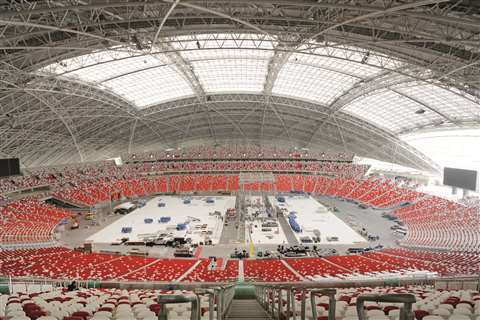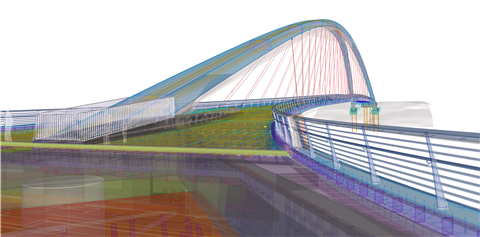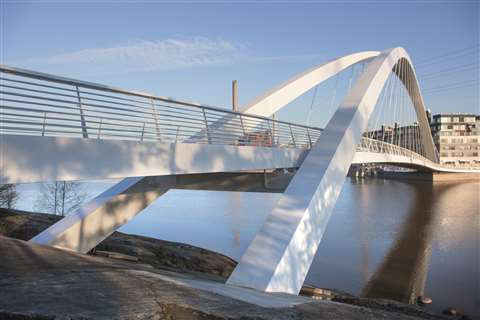BIM: Getting with the times
04 June 2018
The construction industry has some catching up to do – statistics show that the industry has a low level of productivity. Information technology might provide the boost it is looking for and building information modelling (BIM) could play a central role, with its promise to streamline the whole construction process.

Although BIM is not particularly new, it is still in its early stages of development. Since it is so broadly applicable, Brett Stefanko, manager of innovation for infrastructure at Bechtel, said that the successful implementation of BIM depends not so much on the type of project in question but on the surrounding conditions that determine whether BIM could be used effectively.
“The first condition is timing. BIM is best implemented at the beginning of a project, during its conceptual and development stages. Collaborative development with all key stakeholders is crucial. The process isn’t easy, as BIM development is still in its initial stages, with the technology and its sophistication changing rapidly. However, thinking through the data needs and requirements for the full lifecycle of the project will reap great rewards,” said Stefanko.
The second condition is an engaged supply chain that has the capacity to deal with the demands that BIM can place on it. This includes design partners, material and equipment suppliers, and subcontractors.
Stefanko said, “The third condition is choosing the right contractor with a full vision of the EPC (event-driven process chain) and a history of successful project integration.”
At Bechtel, it was said that BIM is a standard execution strategy, incorporated into the work processes and procedures for every single project.
Collaboration
Magdalena Pyszkowska, global head of BIM development at Bouygues, echoed Stefanko’s thoughts, saying, “BIM is applicable whenever you have an environment that is open to collaboration. The appropriate IT infrastructure, tools accessibility and understanding of common BIM targets allow a project’s teams to apply BIM correctly.”
By better connecting the various teams working on a project and offering clear visualisations of constructed objects and work sequences, BIM makes the construction process more transparent. In this way, it allows for quicker and more effective decision-making at each stage of the project.
Stefanko said, “Without BIM, projects move at the pace of a document. Quality and control are managed through multiple handoffs between functions and layers of management. Each step creates an opening for errors to be introduced, delays to occur and accountability to become clouded.
“With BIM, teams can collaborate quickly and integrate seamlessly through visual design reviews. Quality can be automated, reducing errors and omissions, and data janitorial work can be reduced or even eliminated.”
Andy Dickey, business development manager at Trimble, added that up-to-date machine-readable information can be used throughout the process. “Information does not die in one stage of the project but rather lives on to the subsequent stages,” he said.
The ability to react to changing conditions, such as material prices, is also enhanced – so long as the appropriate supply chain is in place.

This was true with Bouygues’ construction of the Singapore Sports Hub – a project that included the building of a 55,000-seat stadium, a covered 6,000-seat aquatic centre and a modular 3,000-seat sports arena.
Pyszkowska said, “3D modelling helped us react swiftly to changes requested by architects and the client, and it enhanced the flow of dialogue.”
BIM does have some teething problems though. Although there appears to be positive momentum in the uptake of BIM within the engineering, procurement and construction industry, there are barriers to using BIM. Dickey commented, “BIM’s greatest weakness is in the ability of applications throughout the process to utilise BIM data.”
Involvement of all parties
If the parties involved in a project do not all have the ability to connect with a shared model, the whole BIM concept, which aims for full transparency, is undermined because certain elements within the process become opaque.
Pyszkowska said that latecomers to BIM – which is the majority of companies – are lagging behind early adopters by about two or three years, and this is because it is difficult to adopt.
The implementation of BIM requires significant early investment, for instance to map out a deployment strategy and create a coding and classification system.
Stefanko said, “Creation of a strong object library, with mature attributes, and a robust Level of Design (LOD) that will serve the project from conception through design, construction, operation, and decommissioning, requires foresight and experience.
“A poorly-developed BIM concept, with weak requirements and limited vision, will create confusion and inefficiency, and lead to poor or improper decision making. Integrating multiple suppliers, design partners and key stakeholders in a dynamic and evolving environment is not easy.”
It is a challenge to connect a diverse range of separate tools and databases in a single digital model, especially when there is the added complexity that each element is dynamic. This can create a problem for scope tracking.
The solution used by Bechtel is Master Data Management, which is a dynamic project coding system that allows various attributes to be assimilated into the project information model.
Stefanko said, “Industry standards can be mapped to integrate with similar assets in the customer portfolio while maintaining the individuality of the component.
“Bechtel’s solution is built on a Project Delivery Matrix (PDM), which visually represents the scope and links the design, construction, commissioning and handover phases. Inputs from different disciplines are captured in the PDM, linking a geographic project breakdown with the function or purpose of each asset.”
What’s next?
Looking to the future of BIM, Pyszkowska speculated that with the integration of IoT (the Internet of Things) into BIM, contemporary design practice could be totally reinvented.
Dickey suggested that its scope will broaden, saying, “BIM will increasingly be integrated into all applications throughout the constructible workflow. It will move from being design-focused to more and more serving construction.”
For Stefanko, there are two major areas of potential development – the supply chain and the full-lifecycle operation and maintenance of assets.
“As the supply chain becomes more sophisticated and comfortable with BIM, I believe we will see rapid improvement in project efficiencies and productivities. Rapid and effective design change able to capitalize on shifts in the markets will become the norm,” said Stefanko.
“Owners and operators will be able to integrate their assets more fully and easily into the asset environment, leading to more efficient operations, maximising output and profitability, while minimising downtime. Upgrades and maintenance will be more effective and less time consuming. Also, operational data could be consumed and mined across the fleet of assets for valuable insights.

Case study: Grandfather’s Bridge
BIM was used from start to finish on the recent construction of the Grandfather’s Bridge in Helsinki, Finland, which has a span of 144m, a width of 4m, and a deck that is hung with 22 tension-rod pairs.
With the aim of achieving paperless design and construction, software company Tekla – owned by Trimble – created new practices for transferring BIM data from one project party to another. Tekla wanted to make its software easy for the contractor Kreate to use, since the firm was new to using the technology.
Aki Kopra, project engineer at Kreate, said, “In the bidding phase of this project, the building information model was an official and binding document. I think that this type of method is becoming more common, but for me this was the first project in which we had a fixed model to support our estimation calculation during the bidding phase.”
By streamlining the bridge’s planning process, BIM helped to avoid errors further down the line, which was said to have resulted in time savings.
Jarkko Savolainen, building information specialist at A-Insinöörit Oy, the project’s BIM consultants, said, “The planning process is easier and clearer with BIM. It also provides more transparency for all the different parties of the project. BIM allowed the site crew to see and understand the structure of the bridge. This makes planning work, as well as the entire project, more fluent, quicker and flawless.”

BIM was used not only for the design of the Grandfather’s Bridge but also for setting up schedules, and monitoring and supporting the fabrication and erection of various elements. The status of the steel structures, for example, was broken down into three phases for scheduling – design, fabrication and installation.
This facilitated fluid collaboration between the construction site and fabrication operations because the workshop that manufactured the steel structures was connected to the model and its schedules were synchronised.
The project parties chose Tekla Model Sharing to access the combined model, meaning that everyone involved was able to use a constantly updated model. This included the client, the City of Helsinki, who could be shown visualisations of the project as it progressed.




